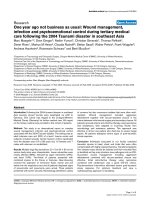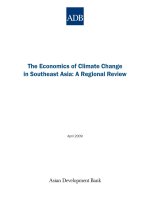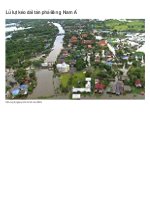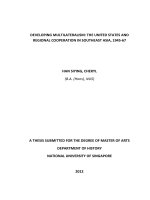Contemporary maritime piracy in southeast asia
Bạn đang xem bản rút gọn của tài liệu. Xem và tải ngay bản đầy đủ của tài liệu tại đây (2.39 MB, 282 trang )
CONTEMPORARY MARITIME PIRACY
IN SOUTHEAST ASIA
XU KE
NATIONAL UNIVERSITY OF SINGAPORE
2006
CONTEMPORARY MARITIME PIRACY
IN SOUTHEAST ASIA
XU KE
Master of Economics, Xiamen University
A THESIS SUBMITTED FOR THE DEGREE OF DOCTOR OF PHILOSOPHY
SOUTHEAST ASIAN STUDIES PROGRAMME
NATIONAL UNIVERSITY OF SINGAPORE
2006
- i -
ACKNOWLEDGEMENTS
Many people deserve my thanks for making this dissertation possible. I
should like to express my deepest gratitude to my supervisor, Natasha Hamilton-
Hart, for her brilliant advice and encouragement from start to finish of this study. I
would also like to express my thanks to my thesis committee at NUS, Anthony
Reid and Liu Hong, who have given valuable suggestions during my thesis writing.
I am grateful for other professors in NUS, Reynaldo C. Ileto, Goh Ben Lan, Robert
Beckman and K. Raguraman for their helpful comments, and I would like to thank
the maritime security experts in IDSS, NTU, Sam Bateman, Joshua Ho and Gerard
Graham Ong, for generously sharing their views with me.
I would particularly like to thank the following scholars and maritime
experts who I have learned very much from during my fieldwork in Indonesia,
Malaysia, Singapore and China: James F. Warren, Hasjim Djalal, Mak Jun Num
and Iskandar Sazlan of the Maritime Institute of Malaysia (MIMA); Zou Keyuan of
the East Asian Institute (EAI); Li Jinmin, Nie Deling of the Research School of
Southeast Asian Studies, Xiamen University; Wang Yizhou of the Chinese
Academy of Social Sciences; Philips J. Vermonte, Begi Hersulanto and Edy
Prasetyono of the Centre for Strategic and International Studies, Indonesia (CSIS);
and Jayant Abhyankar and Noel Choong of the ICC International Maritime Bureau
Piracy Reporting Centre.
ii
My fieldwork in China, Indonesia, Malaysia and Singapore was greatly
facilitated by research institutions in each country. I am grateful to the following
institutions: the Research School of Southeast Asian Studies, Xiamen University;
the Chinese Academy of Social Sciences, the Public Security Ministry of PRC, the
Maritime Safety Administration of PRC; the Centre for Strategic and International
Studies, Indonesia (CSIS), the University of Indonesia, the Indonesian National
Shipowners’ Association (INSA), the Maritime Institute of Malaysia (MIMA), the
East Asian Institute (EAI), the Institute of Southeast Asian Studies (ISEAS), the
Institute of Defence and Strategic Studies at NTU (IDSS), Singapore.
I should like to thanks all informants I have interviewed. Besides this, I
would like to express my thanks to Liu Zhiyong and Wang Jiling, whose hospitality
made my stay in Jakarta much easier.
Finally, I must thank my wife, Qinqin, my mother and my in-laws, who
have been taking good care of my daughter, Yo-Yo, during my studies at the
National University of Singapore. When I left home, Yo-Yo was just born and now
she can call me Papa very sweetly over the phone.
iii
TABLE OF CONTENTS
ACKNOWLEDGEMENTS i
TABLE OF CONTENTS iii
LIST OF ABBREVIATONS vi
LIST OF FIGURES viii
LIST OF ILLUSTRATIONS viii
LIST OF MAPS viii
LIST OF TABLES viii
SUMMARY ix
CHAPTER 1 1
INTRODUCTION 1
Research Questions 3
Analytic Framework and Arguments 4
Pirates and the Shipping Industry 5
Pirates and States 6
Interstate Relations on Anti-piracy Cooperation 8
Literature Review 10
Piracy in Southeast Asian history 10
Piracy in Contemporary Southeast Asia 12
Contribution of this dissertation to the literature 15
The Definition of Piracy 17
Data Sources on Contemporary Piracy 20
Statistics 20
Witness Accounts 21
Author’s Interviews 22
Outline of the dissertation 23
CHAPTER 2 25
PIRACY IN SOUTHEAST ASIA: A HISTORICAL REVIEW 25
Chapter Preview 25
Part I. Piracy and Seaborne Trade before the Colonial Period 26
Nanhai Trade and the Chinese Tributary System 26
Piracy in the Early History of Southeast Asia 28
Part II. The Advent of European Colonisers in Southeast Asia 32
Portuguese 32
The Spaniards 33
The Dutch 33
The British 35
The Relations between European Colonisers and Chinese Empires 36
Part III. Chinese Pirates in the South China Sea 40
Illicit Seaborne Trade and Chinese Pirate merchants 40
Part IV. Piracy in Colonial Southeast Asia 50
The Iranun and the Balangingi 51
The Suppression of Malay Pirates 54
Part V Lessons Learned from the Past 57
The Rise and Fall of Piracy in Southeast Asian History 57
The Evolution of Piracy 58
iv
Anti-piracy Operations 60
Conclusion 63
CHAPTER 3 64
THE SHIPPING INDUSTRY AND PIRACY IN SOUTHEAST ASIA 64
Chapter Preview 64
Part I. Shipping Industry and Piracy in Colonial Southeast Asia 65
The Shipping Industry in the Colonial Era 65
The Shipping Industry and Piracy 70
Part II. The Development of the Contemporary Shipping Industry in Southeast Asia 72
Fleet Development in Southeast Asia 74
Globalisation and the Southeast Asian Shipping Industry 78
Seaborne Trade Routes and Chokepoints 81
National Maritime Interests of Littoral Countries 87
Part III. Contemporary Piracy in Southeast Asia 89
The IMB Piracy Reports 89
Piracy Trends (1990–2005) 92
The Victim Ships 94
Part IV. Shipping Industry Response 96
The Federation of ASEAN Shipowners’ Associations (FASA) 96
The Asian Shipowners Forum 97
Part V The Dilemma of the Shipping Industry 100
Flags of Convenience 101
Reasons for Flagging Out 102
Piracy and Insurance 105
Conclusion 108
CHAPTER 4 111
PIRATES AND STATES 111
Chapter Preview 111
Part I. The Pirates 112
Small Pirate Gangs 112
International Criminal Syndicates 115
The Modus Operandi of Pirates 118
Pirate Weapons and Equipment 138
Part II. Anti-piracy Operations by Littoral Governments 140
Anti-piracy Law Enforcement Agencies and their Capabilities 140
Assessment on Capabilities of Maritime Security in the Littoral States 148
Domestic Laws on Maritime Piracy 149
Part III. Interaction between Pirates and States 152
Collusion between Pirates and Law Enforcement Officials 152
Part IV. Roots of the Collusion 156
Indonesian National Army (TNI) 157
Chinese People’s Liberation Army (PLA) 158
Malaysia and Singapore 161
Conclusion 161
CHAPTER 5 163
INTERSTATE ANTI-PIRACY COOPERATION 163
Chapter Preview 163
Part I. Anti-piracy Cooperation and International Legal Instruments 165
Anti-piracy Agreements and Implementation 165
International Legal Instruments 166
v
Part II. Anti-piracy Cooperation in Southeast Asia (Phase 1, 1990–2001) 169
ASEAN and Anti-piracy Cooperation 170
Japanese Anti-piracy Initiatives 171
Assessment 174
Part III. Problems in Anti-piracy Cooperation in the Littoral States 176
Divergent National Interests, Priorities and Incentives 176
Anti-piracy Policies and Agreements 181
Implementation of Anti-piracy Cooperation 182
Part IV. International Anti-piracy Cooperation (Phase 2, 2002–2005) 184
ASEAN Regional Forum (ARF) 184
Asian Security Summit (Shangri-la Dialogue) 185
Littoral States’ Responses 187
ASEAN in Action 189
China Marches On 190
ReCAAP 191
Assessment 192
IMO and Anti-piracy Cooperation 193
IMO Responses after 9/11 195
ISPS Code 195
Conclusion 196
CHAPTER 6 198
CONCLUSION 198
Explaining the Evolution of Contemporary Piracy 198
Dilemmas in Shipping Industry 200
Incentives regarding anti-piracy operations in the littoral states 201
Capabilities 203
Historical Turning Points and the Fall of Piratical Incidents 204
Historical Continuity and Transformation 206
Continuity 207
Transformation 208
BIBLIOGRAPHY 212
APPENDICES 255
vi
LIST OF ABBREVIATONS
AFRAMAX Average Freight Rate Assessment Maximum
ARF
ASEAN Regional Forum
ASF Asian Shipowners Forum
BAKORKAMLA Badan Koordinasi Keamanan Laut
BCV Barge Carrying Vessels
dwt deadweight tonnage
FASA The Federation of ASEAN Shipowners' Assications
EIC East India Company
FOC
Flags of Convenience
GPS
Global Positioning System
GRT gross registered tonnage
GT Gross tonnage
ICC
International Chamber of Commerce
IMB
International Maritime Bureau
IMB-PRC
international Maritime Bureau Piracy Reporting Centre
IMO International Maritime Organization
INSA
Indonesian National Shipowner’s Association
ISC Information Sharing Centre
ISPS CODE
International Ship and Port Facility Security Code
ITF the International Transport Workers’ Federation
JSA Japanese Shipowners’ Association
KPLP
Kesatuan Penjaga Laut dan Pantai
LNG Liquefied natural gas
LPG Liquefied petroleum gas
MECC
Maritime Enforcement Coordinating Centre
MISC Malaysian International Shipping Corporation Berhad
MMEA
Malaysian Maritime Enforcement Agency
MOL Mitsui O.S.K. Lines Ltd.
MPA
Maritime and Port Authority
MSC Maritime Safety Committee
NOL Neptune Orient Lines
NYK Nippon Yusen Kaisha
OBO oil/bulk/ore carrier
OOCL Orient Overseas Container Line
vii
PSA
Port of Singapore Authority
PTP Port of Tanjung Pelepas
ReCAAP
The Regional Cooperation Agreement on Combating Piracy
and Armed Robbery against Ships in Asia
RMN
The Royal Malaysian Navy
RMSI
Regional Maritime Security Initiative
RSN
Republic of Singapore Navy
SLOCs
Sea Lines of Communication
SOLAS the International Convention for the Safety of Life at Sea
SUA
Convention for the Suppression of Unlawful Acts Against
the Safety of Maritime Navigation
SSA
Singapore Shipping Association
TEU twenty-foot equivalent unit
TNI
Tentrara Nasional Indonesia
TSS Traffic Separation Scheme
UKC Under Keel Clearance
ULCC Ultra Large Crude Carrier
UNCLOS
United Nations Convention on the Law of the Sea
VLCC Very Large Crude Carrier
VOC
Vereenigde Ost-Inische Compagnic
viii
LIST OF FIGURES
Figure 1The Chart of Analytic Framework 4
LIST OF ILLUSTRATIONS
Illustration 1 Iranun Pirate in the 19th Century (Source: Tarling, Piracy and Politics). 52
Illustration 2Weng Shiliang caught by the Chinese Police. (Photo: Wang Wei) 128
Illustration 3 Soni Wee dispatched to court from jail. (Photo: Wang Wei) 129
Illustration 4 Jia Hongwei (left), Soni Wee (middle) and Weng Shiliang (right) in court,
Shanwei, 1999 (Photo: Wang Wei)
132
LIST OF MAPS
Map 1 Monsoon seaborne trade in Souteast Asia in early fifteenth century 27
Map 2Commodity Flow and the main Straits 84
Map 3The Straits of Malacca and Singapore 86
LIST OF TABLES
Table 1 Actual and Attempted Piracy Attacks in Southeast Asia (1992-2006) 93
Table 2 Types of Ships Attacked, January–December 1994–2005 95
Table 3The Continuity of Piracy in Southeast Asia 208
Table 4 The Transformation of Piracy in Southeast Asia 210
ix
SUMMARY
This dissertation reveals the underlying reasons behind the rise and
fall of contemporary maritime piracy (1990–2005) in Southeast Asia, focusing on
the three littoral states of the Straits of Malacca, Indonesia, Malaysia, and
Singapore, together with China. The dissertation examines three sets of
interactions amongst the non-state actors and state actors: pirates and the shipping
industry, pirates and states, and interstate relations on anti-piracy cooperation in
Southeast Asia.
The dissertation argues that the booming seaborne trade since the 1990s,
which has generated large volume of cargoes passing through the Straits of
Malacca, has provided easy prey for pirates, and that dilemmas in the shipping
industry have facilitated piracy. Poor economic conditions and unstable political
situations in Southeast Asia, especially during and after the Asian Financial Crisis
of 1997–1998, have caused a surge in incidents of piracy. Furthermore, corrupt
officials in the littoral countries, who are alleged to be in collusion with pirates,
have abetted piracy. Anti-piracy cooperation in Southeast Asia has been
hampered by differing incentives and priorities in littoral states regarding anti-
piracy operations. A lack of capabilities in some littoral states, especially
Indonesia, have further reduced the effectiveness of anti-piracy cooperation.
x
In the aftermath of 9/11, the littoral states have made policy shifts in response
to the enormous external pressure to suppress piracy. The incentives in and
capabilities of the littoral states on anti-piracy cooperation have been enhanced,
together with the implementation of international maritime security measures, and
for these reasons, piracy in the Straits of Malacca and the South China Sea have
significantly declined, with this trend continuing up to the present.
This dissertation reviews the history of piracy in Southeast Asia, and
identifies four main variables behind the rise and fall of piracy: “prey, pirate,
politics and place”, as well as other factors, such as incentives in and capabilities of
anti-piracy operations. The dissertation concludes with a summary of the historical
continuity and transformation of piracy in Southeast Asia, and offers a prediction
regarding piracy trends in the near future.
1
CHAPTER 1
INTRODUCTION
Introduction
Reports on sea raiders and sea raiding activities pepper the pages of
Southeast Asia’s long maritime history. According to the earliest historical record
for the region, this phenomenon has existed since the first century.
1
Making their
way into these waters in the early 16
th
century, the European colonisers—the
Portuguese, the Spaniards, the Dutch and the British— successively seized the
main entrepôts and set up their colonial domains in Southeast Asia. From 1717, the
British began to use the word “piracy” to refer to those indigenous people who
attempted to impede their trading in the Straits of Malacca.
2
This meaning of the
term “piracy” reflected a European perception of indigenous people as barbarous,
primitive and in need of civilising. The word “piracy”, as a loose term for crimes
that take place at sea, is still commonly used today, as will be discussed in the
following section that covers the definition of contemporary piracy.
The European colonizers took pains to suppress piracy, and at the same
time, anti-piracy operations could be used to justify and expand their colonial state-
1
Ban Gu (b.32-d.92), Hanshu Dili Zhi Huishi [The Annotated Geography Book of Annals of
Han Dynasty] (Anhui: Anhui Jiayu Chubanshe, 2006), 518.
2
Alfred P. Rubin, The Law of Piracy, 2nd ed. (Irvington-on-Hudson, N.Y.: Transnational
Publishers, 1998), 241.
2
building activities.
3
With the help of coercive measures and new technology, such
as steamships and powerful firearms, the Europeans eventually gained the upper
hand over indigenous pirates. Piracy on a large scale had dwindled by the
beginning of the 20th century.
4
This decline will be detailed in the following
chapter.
After the end of the Cold War, however, piracy in Southeast Asia and the
South China Sea made a spectacular comeback. According to the International
Maritime Bureau’s ‘Piracy and Armed Robbery against Ships Annual Report’, the
number of piracy incidents worldwide increased rapidly after the mid 1990s. The
number peaked in 2000 at 469 incidents, more than five times that of 1991.
5
The
most piracy-prone areas were in Indonesian waters, the Straits of Malacca and the
South China Sea.
After the terrorist attacks on New York on 11 September 2001, piracy in
Southeast Asian waters has been seen in an even more serious light, as the
possibility that piracy and terrorism might become synonymous in Southeast Asia
has been expressed by the mass media as well as in academic journals.
6
Intriguingly, three years later, piracy incidents had declined significantly,
particularly in the Straits of Malacca, and this trend has continued up to the
3
Nicholas Tarling, Piracy and Politics in the Malay World: A Study of British Imperialism in
Nineteenth-Century Southeast Asia (Singapore: D. Moore, 1963), 2.
4
Eric Tagliacozzo, Secret Trades, Porous Borders: Smuggling and States along a Southeast
Asian Frontier, 1865-1915 (New Haven & London: Yale University Press), 115.
5
ICC-IMB, "Piracy and Armed Robbery against Ships: Annual Report (1 January –31 December
2004)," (London: ICC International Maritime Bureau, 2005), 4.
6
Adam. J. Young and Mark. J Valencia, "Conflation of Piracy and Terrorism in Southeast Asia:
Rectitude and Utility," Contemporary Southeast Asia 25, no. 2. (2003): 269–283.
3
present.
7
Research Questions
This study looks into what constitute the main variables in the rise
and fall of contemporary maritime piracy in Southeast Asia between 1990-2005.
Piracy is a complex field of study, with its causes and effects intertwined
between the interactions of state actors and non-state actors. The rise and fall of
piracy reflects the political and economic transformation of the various states of
Southeast Asia. After examining the rise and fall of piracy in colonial Southeast
Asia (as discussed in the following chapter), I realised that an in-depth
understanding of piracy could be reached from the analysis of two processes: the
evolution of piracy itself, and anti-piracy operations carried out by governments.
The evolution of piracy demonstrates the political and economic transformation of
interactions amongst the related state actors and non-state actors, while anti-piracy
operations reflect the incentives and capabilities of states in dealing with piracy
issues. These two processes are examined by analysing the following three sets of
interactions.
7
ICC-IMB, "Piracy and Armed Robbery against Ships: Annual Report, 1 January –31 December
2006," (London: ICC International Maritime Bureau, 2007), 5.
4
Analytic Framework and Arguments
The three interlinked sets of interactions amongst state actors and non-state
actors are: pirates and the shipping industry, pirates and states, and interstate
relations on anti-piracy cooperation, as shown in the following “Chart of Analytic
Framework”. This dissertation examines these interactions in the three littoral
states of the Straits of Malacca, namely, Indonesia, Malaysia and Singapore,
together with the part played by China as a major destination of pirate booty.
Figure 1The Chart of Analytic Framework
5
The large triangle in the Chart illustrates the three interlinked relations that
will be examined in this dissertation. From these three sets of relations, I identify
three variables: Pirates, Prey and Politics.
The blue background indicates one more variable, “places”, or the crime
scenes of piracy. These are the Straits of Malacca and the Indonesian waters,
which include the seas around many islands and river networks, the perfect
hangout for piracy. These variables are elaborated on in Chapter 2.
Pirates and the Shipping Industry
Pirates and the shipping industry are key adversaries in contemporary
maritime piracy in Southeast Asia. They are both non-state actors, unlike their
counterparts during the colonial period, when many pirates were state actors, and
the shipping industry was in some cases a part of the colonial state machinery, as
will be discussed in Chapter 3.
Generally speaking, East Asian and Southeast Asian countries have enjoyed
remarkably high and sustained economic growth since the Second World War.
8
The booming economic situation in East Asia has given a fresh impetus to seaborne
trade, and generated a huge cargo flow of oil and industrial materials through the
Straits of Malacca, providing ready prey for pirates.
8
East Asia in this dissertation mainly refers to Japan and China, while Southeast Asia mainly
refers to the Philippines, Malaysia, Thailand, Indonesia and Singapore.
6
Since the shipping industry is the direct victim of piracy, the surge in the
number of piratical incidents is therefore of great concern to this industry. The
analysis of the nexus between the shipping industry and pirates provides practical
insights into contemporary piracy. For instance, modern technology now used on
board ships greatly reduces the number of crew needed on board. However, this
also makes it easier for pirates to seize control of such ships. Bad security
administration in some ports provides opportunities for pirates to commit crimes
against ships, and, furthermore, lax practices in ship registration, such as the “Flag
of Convenience” practice, facilitates the re-registering of hijacked ships by
international criminal syndicates, as will be discussed in Chapter 3.
Pirates and States
The nexus between pirates and states is more complicated than the
relationship between pirates and the shipping industry, involving political and
economic factors, which are the driving forces behind the evolution of piracy and
anti-piracy operations.
A booming seaborne trade and the development of the shipping industry are
the external prerequisites for a surge in piracy. The boom in seaborne trade has
brought about a host of problems for the littoral states. For example, the
degradation of fish habitats has resulted in a tremendous decline in fish stocks and
a slump in fishermen’s income, with Indonesian fishermen suffering considerable
7
losses. This has driven some Indonesian fishermen in fishing villages along the
Straits of Malacca to turn to piracy for a living. They have attacked ships in ports
and at anchorage as a source of easy money. Worsening economic conditions in
Southeast Asia, especially in Indonesia, which was hit hardest during the Asian
Financial Crisis of 1997-1998, have also played an important role in the
recrudescence of piracy.
Apart from petty piracy in ports and anchorages, there are criminal
syndicates in Southeast Asia, whose aims are to rob and hijack ships and cargo
travelling though the Straits of Malacca. These criminal syndicates consist of well-
trained personnel using fast boats, modern weapons and sophisticated
communications. These criminal syndicates have established links to the black
market, where they are able to dispose of their stolen cargoes. They also engage in
other transnational crimes, such as smuggling, marine fraud, drug and human
trafficking, and even illegal fishing. Corrupt officials in the littoral countries,
especially in Indonesia, are alleged to be in collusion with these syndicated pirates.
In this study, I will discuss anti-piracy law enforcement agencies and
domestic laws against piracy in the littoral states, and draw attention to patterns of
collusion between pirates and corrupt law enforcement agencies. The analysis
focuses on Indonesia and China, for Indonesia is the most piracy-prone zone, and
China was the main destination of pirates’ booty in the 1990s. As shown in
Chapter 4, corrupt officials in Indonesia and China have aided this process by
providing information and logistics support for pirates, making piracy difficult to
8
suppress.
Interstate Relations on Anti-piracy Cooperation
Piracy in Southeast Asia is generally a transnational crime involving parties
or processes in more than one country. As such, the suppression of piracy requires
related states to cooperate. Since the early 1990s, the littoral countries have been
cooperating in anti-piracy operations. However, divergences in national interests in
the littoral states have resulted in different priorities and incentives regarding anti-
piracy operations. The national interests of the littoral states have formed the basis
for building anti-piracy policies. For example, in the eyes of Indonesian officials,
piracy in Southeast Asia is petty theft, which does not have a great impact on its
national interests. In contrast, Singapore, which is highly dependent on its ports,
considers piracy as a threat to its national security. Such perceptions, in turn, are
reflected in the states’ priorities in and incentives for combating piracy.
In terms of priorities in and incentives for combating piracy, Indonesia has
given the lowest priority to anti-piracy operations, Singapore the highest, while
Malaysia falls in between these two countries. These differences are reflected in
anti-piracy policies and agreements. For example, the Indonesian government was
reluctant to spend money on combating piracy, which was not their priority
concern as they had more important maritime issues to deal with, such as illegal
fishing in territorial waters.
Anti-piracy cooperation in Southeast Asia can be divided into two phases, with
9
the turning point being the September 11, 2001 terrorist attacks on America
(hereafter, 9/11):
Phase One (1992-2001). Anti-piracy cooperation was characterised by low-
profile, bilateral and multilateral cooperation amongst ASEAN and East Asian
countries. Japan played an important role in anti-piracy initiatives. However, these
initiatives were not effective in suppressing piracy. On the contrary, piratical
incidents continued to rise in number.
Phase Two (2002-2005). In the aftermath of 9/11, the possibility of a terrorism
and piracy nexus raised worldwide concern. The United States attempted to
integrate anti-piracy operations into its global anti-terrorism framework, through
the Regional Maritime Security Initiative (RMSI), together with the International
Ship and Port Facility Security Code (ISPS Code), created by the International
Maritime Organization (IMO). At the same time, the Untied States dominated
international conferences on maritime security issues, such as the ASEAN
Regional Forum (ARF), and the Asian Security Summits (known as the “Shangri-la
Dialogue”). Against this backdrop, regional anti-piracy cooperation in Southeast
and East Asia was enhanced. The Regional Cooperation Agreement on Combating
Piracy and Armed Robbery against Ships in Asia (ReCAAP) was concluded in
2004. The ReCAAP is the first government-level organization amongst 16 Asian
countries, with an aim to enhance multilateral cooperation in anti-piracy operations
(as will be elaborated on in Chapter 5).
Following 9/11, the littoral states have been under considerable external
10
pressure, mainly from the United States, to combat piracy. As the incentives to
combat piracy were thereby raised, there were some policy shifts, more patrols
began to be carried out, and piracy incidents began to decline. After three years’
efforts (2002-2004) by the littoral states and other stakeholders, piracy in the Straits
of Malacca and the South China Sea has declined significantly from 2004 up to the
present.
Literature Review
Piracy in Southeast Asian history
Accounts of piracy in early Southeast Asia are scattered throughout Chinese
historical records. This dissertation draws heavily on these records, many of which
will appear in the English language for the first time. Western scholars are familiar
with Shi Faxian’s accounts of piracy in the Straits of Malacca, and Wang Dayuan’s
account of piracy in Temasek (Singapore).
9
However, there are other Chinese
records of piracy in Chinese travel notes and imperial archives: for example, Ying
Ya Sheng Lan, Zhu Pan Zi and The Imperial Archives. This study presents insights
drawn from these newly translated materials in Chapter 2.
9
Shi Faxian, Faxian Zhuan Jiaozhu [Annotated Faxian Autobiography] (Shanghai: Shanghai
Guji Chuanshe, 1985), and Wang Da-yuan, Dao Yi Zhi Lue Jiao Shi [Notes on Barbarian
Islands](Beijing: Zhong Hua Shu Ju, 1981).
11
Much solid work, based on colonial records, has been done by scholars on
piracy during the colonial period. For example, Nicholas Tarling discusses the role
of anti-piracy operations in British policy in the nineteenth century.
10
Carl Trocki
has examined the role of the Temenggong, known as the “Prince of pirates”, and
the development of Johor and Singapore between 1784 and1885.
11
Timothy
Barnard has studied maritime violence and Malay identity in Siak.
12
James F.
Warren and Laura Junker have investigated maritime raiding and pirate-state
relations in the Spanish Philippines.
13
Eric Tagliacozzo has discussed piracy and
state building in the Dutch Indies.
14
Joseph à Campo has analysed piracy in the
Dutch Indies.
15
These scholars have provided insights into piracy in colonial Southeast Asia
from different perspectives, which will be set out in the following chapter. The
reason for devoting a whole chapter to discussing piracy in Southeast Asian history
is that we can draw lessons from the past, that will in turn inform an analytic
framework for understanding contemporary piracy.
10
Tarling, Piracy and Politics, 2.
11
Carl A. Trocki, Prince of Pirates: The Temenggongs and the Development of Johor and
Singapore, 1784–1885 (Singapore: Singapore University Press, 1979).
12
Timothy Barnard, “Texts, Raja Ismail, and Violence: Siak and the Transformation of Malay
Identity in the Eighteenth Century,” Journal of Southeast Asian Studies: Special Issue on Malay
Identity, vol. 32, no. 3 (2001), 331–42.
13
James Francis Warren, The Sulu Zone 1768–1898: The Dynamics of External Trade, Slavery,
and Ethnicity in the Transformation of a Southeast Asian Maritime State (Singapore: Singapore
University Press, 1981); Laura Lee Junker, Raiding, Trading, and Feasting: The Political
Economy of Philippine Chiefdoms (Honolulu: University of Hawaii Press, 1999).
14
Tagliacozzo, Secret Trades, Porous Borders.
15
Joseph N. F. M. à Campo, "Discourse without Discussion: Representations of Piracy in
Colonial Indonesia 1816–25," Journal of Southeast Asian Studies 34, no. 2 (2003):199–214.
12
From an analysis of the rise and fall of piracy during the colonial period, I
have developed the analytic framework for studying piracy, which examines the
interactions between the three pairs of actors. Furthermore, I have identified four
variables that influence the rise and fall of piracy: Pirates, Prey, Politics and Places,
as will be explained in the following chapter. Later, I will reveal several
interesting historical continuities and transformations, by comparing these
variables in the contemporary period with their parallels in the colonial period.
Furthermore, the studying of these variables makes it possible to predict piracy
trends in the near future, as will be discussed in the concluding chapter.
Piracy in Contemporary Southeast Asia
There are many scholarly accounts of contemporary piracy, written from
various perspectives. Jack Gottschalk and Brian Flanagan provide a historical
perspective on piracy worldwide, introduce its modern dimensions, and present
possible solutions to suppress piracy. However, they focus on piracy in the golden
ages of America and the Mediterranean, rather than on piracy in Southeast Asian
history, and the parts regarding contemporary piracy in Southeast Asia leave
several important gaps.
16
Peter Chalk, one of the pioneering scholars of contemporary piracy in
16
Jack A. Gottschalk and Brian P. Flanagan, Jolly Roger with an Uzi: The Rise and Threat of
Modern Piracy (Annapolis, Md.: Naval Institute Press, 2000).
13
Southeast Asia, emphasises that state sponsorship and support has contributed to
modern piracy in Southeast Asia. He notes that a variety of maritime bodies have
long asserted that certain gangs in Southeast Asia are operating with official
backing and training, which accounts for the quasi-military and ‘professional’ style
of contemporary piracy. This dissertation incorporates these claims into its
analysis. However, Chalk’s claims about a “Chinese Conspiracy” appear to be
spurious, as will be discussed in Chapter 4.
17
Barry H. Dubner, Alfred P. Rubin, Hasjim Djalal, Robert C. Beckman and
Zou Keyuan have studied piracy from an international law perspective. Dubner
has made a thorough exploration of laws relating to international maritime piracy,
compiled much relevant information and responded to some of the questions posed
by legal publicists.
18
Rubin has looked into the origins and the evolution of the
concept of piracy in England and the United States, discussed British practice on
piracy in the 19
th
century, and has discussed the international law on piracy in the
20
th
century.
19
Djalal has discussed the articles relating to piracy in the United
Nations Law of the Sea Convention (UNCLOS) and their implications, and
investigated the piracy situation in Indonesia, as well as international anti-piracy
cooperation.
20
Beckman has analysed the reported piracy incidents and the
attempts by the international community to deal with this problem. He concludes
17
Santo Darmosumarto, "The P.R.C. and Piracy in the South China Sea," (MA Thesis, University
of Victoria, 1997).
18
Barry Hart Dubner, The Law of International Sea Piracy: Developments in International Law,
V. 2. (The Hague: M. Nijhoff Publishers 1979).
19
Rubin, The Law of Piracy, 241–263.
20
Hasjim Djalal, "Piracy in Southeast Asia: Indonesian & Regional Responses," Jurnal Hukun
International[Indonesian Journal of International Law] 1, no. 3 (2004): 419–440.









